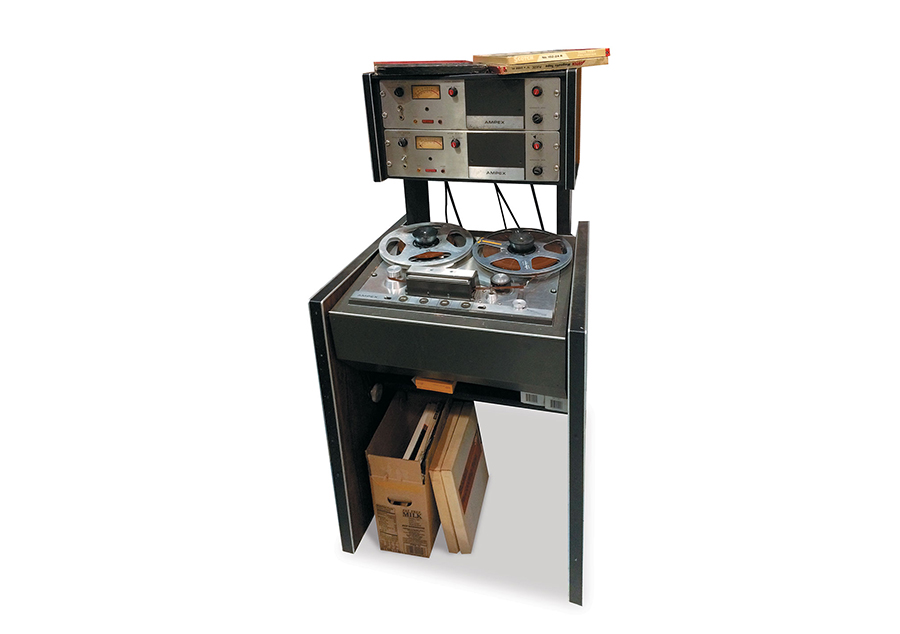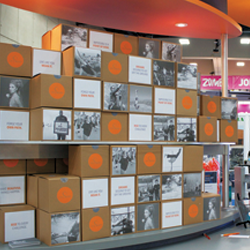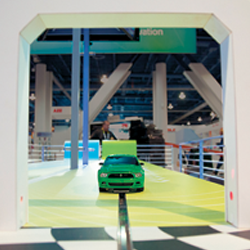|
traffic builders

PHOTOs: Universal Audio Inc.
Musical Legacy
Universal Audio Inc.'s Dan Fulop devises an authentic recording-studio display that helps boost leads and Twitter mentions by 73 and 50 percent, respectively. By Linda Armstrong
With that tried-and-true approach in mind, Fulop was set to launch the company's newest piece of audio-interface technology at the upcoming trade show in Anaheim, CA. But with less than three months to go before NAMM's opening day, Universal Audio pulled the plug on those plans, pushed the product's launch date to several months after NAMM, and sent Fulop's neatly arranged ducks into a veritable trade show tailspin. In one fell swoop, Fulop found himself back at the drawing board with a 20-by-50-foot booth primed to host massive crowds – and no new hardware. What's more, without the new-product lure, Universal Audio was void of a built-in traffic builder and at risk of muted lead counts. In effect, Fulop had a coming-out party with all the embellishments, but the guest of honor was a no-show. 
Universal Audio Inc. used its own equipment to create a one-off photo op and traffic-building tactic. The Heritage Display generated a 73-percent uptick in booth traffic while social-media photo posts created awareness for stay-at-home music professionals.
1. A steady stream of 10 to 15 attendees waited for their chance to pose in the Heritage Display.
A Sour Note2. In keeping with the '60s vibe, the studio walls were covered in wood paneling and pegboard wainscotting. 3. A series of six sound-dampening baffles adorned the display walls. 4. Attendees typed in their contact info on a vintage-style typewriter equipped with a USB connection, which was linked to an iPad. 5. Checkerboard flooring added to the authentic vibe. 6. Attendees posed in vintage, green office chairs behind the famous console. 7. A placard featured photos of famous engineers and musicians using Universal Audio's equipment. 8. Universal Audio replaced the internal components from a 1963 Honeywell camera with a Webcam and used the device to shoot attendee photos on site. 9. Completing the vintage scene, an Ampex 350 two-track tape recorder rested against a wall. 10. The console was flanked by two Altec 604 loud-speakers from the same era. 11. A 65-inch flatscreen on the back wall was framed to look like a window between the control room and the recording studio. 12. One of only 13 such consoles in the world, a classic UA 610 recording console anchored the space. To solve this launch-party predicament, Fulop sat down with Universal Audio's director of marketing, Erik Hanson, and the firm's exhibit house, Czarnowski Display Services Inc., to strategize a new solution. Initially, the team decided to retool the majority of the exhibit activities to focus on existing technology as opposed to the new hardware on the market. "We'd planned to have music engineers and their artists perform live in the booth to demo the recording technology in real time while also entertaining the audience," Fulop says. So even though the new product wasn't available, the team figured they could still move forward with an experience using existing products. Sure, the booth might not reach the same crescendo Fulop had originally intended, but the footprint would remain mostly unchanged, and the show would go on. 
Actors dressed in period garb posed with attendees and ensured the priceless equipment wasn't inadvertently damaged during the show.
Fulop, however, still needed a way to draw traffic and give attendees something to talk about during and after the show, much the way they would have rattled on about the new product. "Whatever traffic-building technique we came up with had to generate buzz, particularly on social media," Fulop says. "That's because thousands of audio enthusiasts we want to reach are tucked up in their studios rather than at NAMM, yet they follow the show closely on social-media and news sites. They monitor blogs, scour companies' websites for new products, and keep their eyes glued to their Twitter feeds." Given these additional parameters, then, Fulop and the team held a brainstorming jam session. Ultimately, their attention turned to the company's rich history, which proved to be a wealth of inspiration. A piece of musical history in and of itself, Universal Audio was founded in 1958 by Bill Putnam, who was not only a recording engineer that worked with Nat King Cole, Ray Charles, Frank Sinatra, Duke Ellington, and many others, but also an inventive genius. In fact, he gave birth to much of the classic analog equipment, such as compressors and amplifiers, that was used to create these artists' albums. This rich history lives on today, as the company is one of the only large firms that continues to manufacture classic analog equipment, building each component in its Heritage line by hand in its Scotts Valley, CA, headquarters. However, after Putnam Sr. passed away in the '80s, Bill Putnam Jr. eventually took the helm and added a whole new line of digital equipment and software, including everything from audio interfaces, compressors, and channel strips to a massive line of software "plug-ins" that work with the hardware. "So we're one of the few companies in this industry that has one foot in the past, and one foot in the future," Fulop says. "Our major competitors have been making products for 10 to 15 years, but we have a 60-year history, which creates a level of trust among customers. Plus, when you're selling digital technology that claims to reproduce the sound quality of analog equipment, you'd better know a thing or two about analog. And our level of credibility is above the others because we don't just understand analog equipment; we invented much of it." Not surprisingly, then, Universal Audio's history is part of the firm's booth presence. "We always try to highlight our heritage, so at least a corner of the booth is devoted to our analog equipment," Fulop says. "But as we sat down to brainstorm solutions for 2015, we took a good look at how we were representing this heritage in the exhibit. In 2014, we'd just sort of tossed all of our analog gear into a sad little back corner, and we'd originally planned to do something similar in 2015. So we quickly decided that whatever new tactic we came up with should somehow give more importance to our heritage." This heritage, in fact, was starting to play an increasingly important role in maintaining Universal Audio's market position. In 2012, the firm launched its first audio interface, the Apollo, which took the industry by storm. "Sales immediately took off, and it quickly became the No. 1 selling audio-interface product in the world in the more than $500 price range," Hanson says. 
Text on an in-booth placard explained the Heritage Display's contents and featured the tagline, "Universal Audio, Setting the tone since 1958."
"But by 2015, competitors were starting to nip at our heels," Fulop says. So in order for this big dog to outsmart the industry pups, the firm's heritage was critical. "We decided that 'leaning into' our history and our position as pioneers in the industry would become a key differentiator," Fulop says. "This rich past and analog expertise is something the newcomers simply don't have."Facing myriad challenges and searching for a new heritage-based solution, Fulop and his team dug through Universal Audio's photographic vaults for inspiration. "At some point, we ran across a photo of Brian Wilson in Putnam Sr.'s control room when the Beach Boys were recording Pet Sounds in 1966," Fulop says. "Then the idea dawned. What if we recreated this control room with as much authentic equipment and accoutrements as possible and incorporated a photo op and social-media tie-in for attendees? While we all agreed that sourcing the materials might be a challenge, it would give our heritage the presence it needed while acting as a traffic builder that music enthusiasts couldn't resist." And with that, the Universal Audio Heritage Display was born. Rockin' to the Oldies Approaching the peninsula booth at NAMM 2015, attendees couldn't help but notice a long line trailing along one side of the space. After making their way to the front, attendees discovered a 10-by-10-foot display tucked into the back corner of the Universal Audio booth. Facing the aisle as a sort of stand-alone exhibit, the space was roped off by brass posts and rope stanchions covered in red velvet. Front and center in the space sat a UA 610 recording console, one of the world's first analog recording consoles, which was built by Universal Audio. "Since there were only 13 of these ever made, and Bill Putnam had sold every last one of them in the '60s, we had to hunt high and low to find an authentic console to anchor the space," Fulop says. "And the one we finally located is priceless. It recorded songs like 'Will You Still Love Me Tomorrow?' and 'You've Lost That Lovin' Feeling,' and engineers used it for albums for everyone from Ray Charles to Phil Spector. Having this console in the booth was like having Eric Clapton's guitar on display. Music enthusiasts practically drooled at the sight of it." Positioned on either side of the console were an Ampex 350 two-track tape recorder and two Altec 604 loudspeakers – highly recognizable and regaled relics from the analog era. Behind the console, Fulop devised an ingenious effect that comprised a 65-inch high-definition flatscreen framed to look like a window between the control room and a recording studio. "I wanted something to give the relatively small booth space some depth, so we created this window-like display," Fulop says. "Prior to the show, we assembled various pieces of '60s musical equipment to recreate the look of a recording studio and had a few company interns dress up in period garb. Then we filmed them setting up equipment and moving pieces here and there. At the trade show, the video ran on the flatscreen in the booth, giving the illusion that an engineer was readying the studio on the other side of the 'glass.'" Meanwhile, authentic props, including everything from period-style wood paneling and mod metal furniture to wall-mounted sound baffles and blue-and-white checkered flooring, surrounded the audio equipment. "We spent a long time sourcing these items by scouring eBay and conducting tons of Google searches," Hanson says. 
The booth was so successful in generating show-floor buzz, that compared to the results from NAMM 2014, Universal Audio's leads increased by a whopping 73 percent.
The display, however, wasn't just a look-don't-touch museum exhibit. Rather, two actors clad in '60s-style attire (who were charged with both guarding the precious equipment and engaging attendees) welcomed one or two visitors at a time into the space for a special photo op. Even the photo op screamed "authentic." "To maintain the authenticity of the display, we took the guts out of a 1963 Honeywell camera and replaced them with a Webcam," Fulop says. "So attendees entered the display and took a seat in front of the console. Then one of the actors snapped their picture via a remote control linked to the camera." A printer positioned on the side of the display created takeaway black-and-white photos that featured the tagline "Universal Audio, Setting the Tone Since 1958." But the period-specific experience didn't end there. After the actors scanned their badges, attendees took a seat in front of a special, vintage-style typewriter equipped with a USB connection, which was linked to an iPad resting on the paper roller. To obtain a digital copy of their photo and share it on Twitter or Facebook, attendees typed in their contact information via the typewriter keys, which then sent their data to the iPad and ultimately relayed their photos to the social-media sites. Meanwhile, two monitors attached to the exterior of the display looped the captured photos, giving passersby a glimpse of the action and prompting them to jump in line to make some magical photos of their own. Rounding out the experience, a placard attached to the stanchions featured black-and-white photos of famous engineers and musicians using Universal Audio's equipment, and text included the same tagline found on the photos along with information about the contents of the display. Off the Chart Results Drawn by the mere sight of the famous console – not to mention the curiosity factor of an old-school display amid a show floor – full of high-tech recording wizardry, attendees flocked to the booth in drovesand created a bit of a mosh pit around Universal Audio's space. 
No '60s studio would be complete without an Ampex 350 two-track tape recorder like the one on display.
"There was a constant line of 10 to 15 people waiting to get their pictures taken," Fulop says. "Show management didn't appreciate them standing in the aisle, but the rest of our booth was packed with people listening to the artists and checking out the equipment, so there really wasn't anywhere else for them to go."The booth was so successful in generating show-floor buzz, in fact, that compared to the results from NAMM 2014, Universal Audio's leads increased by a whopping 73 percent – up from 1,425 to 2,472. And of those leads, more than 900 were collected in the Heritage Display. What's more, social-media results blew away the company's previous efforts. Fulop and his team set a lofty goal of increasing show-related Twitter mentions by 50 percent compared to 2014 results. In fact, however, the traffic-building tactic generated an impressive 58-percent increase in mentions, and scored a killer 267-percent increase in potential Twitter impressions compared to the previous year. And while Fulop wasn't focused on Facebook results (seeing as the target audience is far more interested in Twitter), compared to 2014, it scored a 25-percent increase in page "likes" and a 14-percent uptick in potential impressions. Plus, according to Hanson, "While the Heritage Display wasn't aimed at the media specifically, our overall presence at the show attracted tons of media attention. We exceeded all of our previous NAMM results with regard to press impressions, stories written, etc." And famous folks took notice, too. "A ton of music celebrities stopped by to get their picture taken with the console," Hanson says. "We hosted everyone from Stevie Wonder and Herbie Hancock to the guys from Depeche Mode. It was really the top hit of the entire show." Clearly then, Fulop's potential flop turned out to be a platinum success, thanks to a bit of creativity and a trip through the company's photographic vaults. But perhaps one judge said it best with regard to the program's success: "Faced with a last-minute play-it-by-ear challenge, this All Star turned to the company's illustrious history to set the tone for Universal Audio's booth experience. And in doing so, he not only rocked the metrics, but also rolled over the competitors – and reestablished his company as a solid firm with a historic past that can also lead the music industry to the future. Bravo!" E
|
|
|
||||||||||||||||||||||||||||
|
|
||||||||||||||||||||||||||||
|
TOPICS Measurement & Budgeting Planning & Execution Marketing & Promotion Events & Venues Personal & Career Exhibits & Experiences International Exhibiting Resources for Rookies Research & Resources |
MAGAZINE Subscribe Today! Renew Subscription Update Address Digital Downloads Newsletters Advertise |
FIND IT Exhibit & Display Producers Products & Services All Companies Get Listed |
EXHIBITORLIVE Sessions Certification Exhibit Hall Exhibit at the Show Registration |
ETRAK Sessions Certification F.A.Q. Registration |
EDUCATION WEEK Overview Sessions Hotel Registration |
CERTIFICATION The Program Steps to Certification Faculty and Staff Enroll in CTSM Submit Quiz Answers My CTSM |
AWARDS Sizzle Awards Exhibit Design Awards Portable/Modular Awards Corporate Event Awards Centers of Excellence |
NEWS Associations/Press Awards Company News International New Products People Shows & Events Venues & Destinations EXHIBITOR News |
||||||||||||||||||||
|
||||||||||||||||||||||||||||



 Dan Fulop
Dan Fulop


